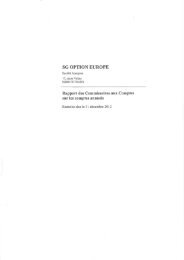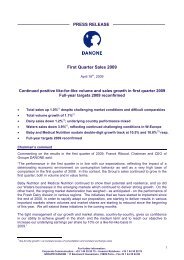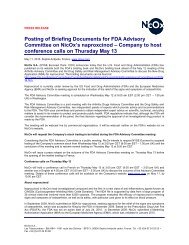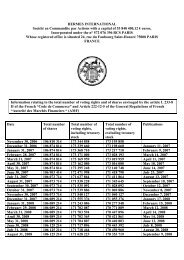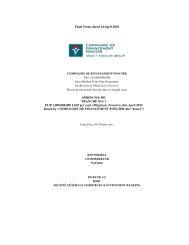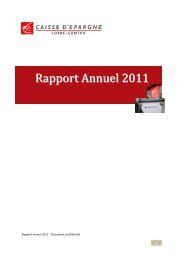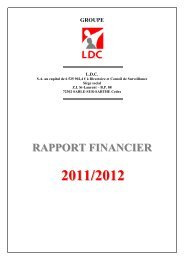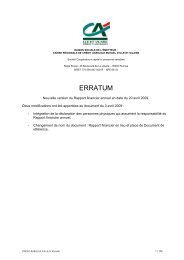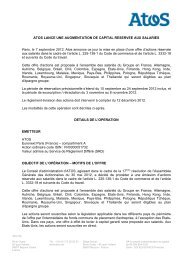Financial Reporting - Rexel
Financial Reporting - Rexel
Financial Reporting - Rexel
Create successful ePaper yourself
Turn your PDF publications into a flip-book with our unique Google optimized e-Paper software.
1.1.3 | Impact of changes in copper price<br />
The Group is indirectly exposed to fluctuations in copper price in connection with its distribution of<br />
cable products. Cables represent approximately 18% of the Group’s sales and copper accounts for<br />
approximately 60% of the composition of cables. This exposure is indirect since cable prices also<br />
reflect suppliers’ commercial policies and competitive environment of markets in which the Group<br />
operates. Changes in copper price have an estimated “recurring” and “non-recurring” effect on the<br />
Group’s performance, assessed as part of the monthly internal reporting process of the <strong>Rexel</strong> Group:<br />
- The recurring effect related to the change in copper-based cable prices corresponds to the<br />
change in the value of the copper included in the sales price of cables from one period to<br />
another. This effect mainly relates to sales;<br />
- The non-recurring effect related to the change in copper-based cable prices corresponds to<br />
the effect of copper price variations on the sales price of cables between the time they are<br />
purchased and the time they are sold, until such inventory has been reconstituted (direct effect<br />
on gross profit). In practice, the non-recurring effect on gross profit is determined by<br />
comparing the historical purchase price for copper-based cable and the supplier price effective<br />
at the date of the sale of the cables by the <strong>Rexel</strong> Group. Additionally, the non-recurring effect<br />
on EBITA corresponds to the non-recurring effect on gross profit, which may be offset, where<br />
appropriate, by the non-recurring portion of changes in distribution and administrative<br />
expenses (principally the variable portion of compensation of sales personnel, which accounts<br />
for approximately 10% of the change in gross profit).<br />
The impact of these two effects is assessed for as much of the Group’s total cable sales as possible<br />
over each period, and in any case covering at least a majority of sales. Group procedures require<br />
entities that do not have information systems capable of such comprehensive calculation to estimate<br />
these effects based on a sample representing at least 70% of sales during the period. The results are<br />
then extrapolated to all cables sold during the period for that entity. On the basis of the sales covered,<br />
the <strong>Rexel</strong> Group considers such estimates of the impact of the two effects to be reasonable.<br />
1.1.4 | Comparability of the Group’s operating results<br />
The Group undertakes acquisitions and disposals that may alter its scope of consolidation from one<br />
period to another. Second, currency exchange rates may also fluctuate significantly. In addition, the<br />
number of working days in each period also has an impact on the Group’s consolidated sales. Lastly,<br />
the Group is exposed to fluctuations in copper price. For these reasons, a comparison of the Group’s<br />
reported operating results over different periods may not provide a meaningful comparison of its<br />
underlying business performance. Therefore, in the analysis of the Group’s consolidated results<br />
presented below, financial information is also restated to give effect to following adjustments.<br />
Excluding the effects of acquisitions and disposals<br />
The Group adjusts its results to exclude the effects of acquisitions and disposals. Generally, the Group<br />
includes the results of an acquired company in its consolidated financial statements at the date of the<br />
acquisition and ceases to include the results of a divested company at the date of its disposal. To<br />
neutralize the effects of acquisitions and disposals on the analysis of its operations, the Group<br />
compares the results of the current year against the results of the preceding financial year, as if the<br />
preceding financial year had the same scope of consolidation for the same periods as the current year.<br />
Excluding the effects of exchange rate fluctuations<br />
Fluctuations in currency rates against the euro affect the value of the Group’s sales, expenses and<br />
other balance sheet items as well as the income statement. By contrast, the Group has relatively low<br />
exposure to currency transaction risk, as cross-border transactions are limited. To neutralize the<br />
currency translation effect on the comparability of its results, the Group restates its comparative period<br />
results at the current year’s exchange rates.<br />
4



